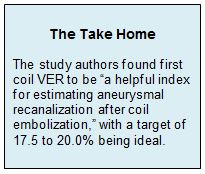Key Points:
- Researchers calculate the first coil VER that carries lowest risk of aneurysmal recanalization
- Target range of 17.5 to 20.0% identified
Targeting an ideal first coil volume embolization ratio (VER) can help reduce the risk of recanalization of normal-sized intracranial aneurysms, according to a retrospective analysis published online January 27, 2017, ahead of print in the Journal of NeuroInterventional Surgery. The authors suggest that interventionalists aim for a range of 17.5 to 20.0% in order to achieve the least recanalization.
Previous research has demonstrated that low VER following aneurysmal coiling is associated with aneurysmal recanalization, write researchers led by Hiroaki Neki, MD of Saitama Medical University International Medical Center (Saitama, Japan). Furthermore, the VER achieved with the first coil has been shown to be a predictor of the final obtained VER.
With this in mind, Dr. Neki and colleagues conducted a retrospective analysis of 609 initial saccular aneurysmal treatments performed between January 2010 and December 2014 at their institution. They sought to determine a target first coil VER that, if attained, would be associated with a reduced recanalization risk. VER was calculated as a percentage of total coil volume/calculated aneurysmal volume.
Excluded from the analysis were all attempted but incomplete procedures as well as retreatment, intraoperative rupture, and stent-assisted coiling cases.
Overall, 97 of the 609 treated aneurysms subsequently recanalized. The investigators compared patients with and without recanalized aneurysms with respect to age, sex, aneurysm location, ruptured aneurysm, aneurysm shape, neck size, maximum aneurysm size, dome-to-neck ratio, aneurysm volume, procedure type, immediate Raymond scale score, first coil VER, and final VER.
Among the variables evaluated, the aneurysmal features of location, rupture status, shape, neck width, size, and volume all differed significantly between the two groups. Also different were the type of procedure (ie, simple vs balloon-assisted vs double catheter), first coil VER, and final VER.
Multivariate analysis revealed that ruptured aneurysm, first coil VER < 10.0%, and final VER < 33.0% all were independent predictors of recanalization (table 1).
Table 1. Predictors of Recanalization
|
|
OR (95% CI) |
P Value |
|
Ruptured Aneurysm |
4.90 (2.65-9.30) |
< .001 |
|
First Coil VER < 10.0% |
2.25 (1.10-4.65) |
.022 |
|
Final VER < 33.0% |
2.01 (1.10-3.66) |
.026 |
Identifying a Target Range
The maximum average VER achieved in normal-size aneurysms (ie, those 3 to 10 mm) was found among patients whose first coil VER was 17.5 to 20.0%. Thus, the authors conclude that this range could be used as a target to help minimize the risk of recanalization.
They point out that obtaining a good first coil VER is highly dependent on the choice of coil type, which “depends heavily on the operator’s judgment.” They recommend, therefore, that first coil selection should be made with the need to obtain a suitable first VER in mind. An added benefit of using first coil VER as a benchmark, they note, is that it can conveniently be calculated after the diagnostic angiogram.
But the authors warn that “the strategies for small or large aneurysms are completely different from those for aneurysms of normal size.” The predictive value of first coil VER applies to normal-sized aneurysms, not large ones, they write.
Source:
Neki H, Kohyama S, Otsuka T, et al. Optimal first coil selection to avoid aneurysmal recanalization in endovascular intracranial aneurysmal coiling. J NeuroInterv Surg. 2017;Epub ahead of print.
Disclosures:
Dr. Neki reports no relevant conflicts of interest.


